Innovation
First, what does the word Innovation mean? By definition, innovation is the act or effect of innovating. In practical terms, it can be understood as the creation of something new or the improvement of something existing. It is the introduction of novelties in management or in the way of doing something - in short: a discovery.
Today, we live in the Information Age, and this is a fact. Information generates power, brings benefits, advantages, new discoveries, and, of course, innovation. Technology walks hand in hand with information, bringing with it the new.
Innovation seems to be "the hot topic," and for that to happen, we go through several stages until we reach the current point. Let’s revisit these eras and discover who can achieve the greatest innovations in the Innovation Board Game!
Game Details
Innovation is a game for 2 to 4 players, recommended for ages 12+, created by designer Carl Chudyk. The artwork of the game is credited to Cara Judd, Anders Olausson, Robin Olausson, Christophe Swal, and Cyril Van Der Haegen.
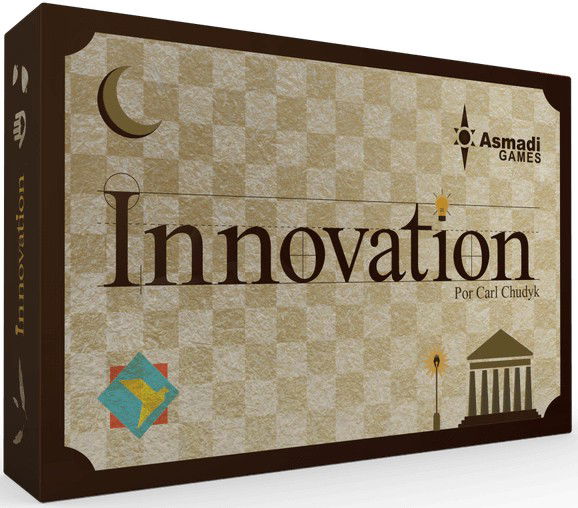
Released in 2010 by Asmadi Games and brought to Brazil by Grok Games in 2019, Innovation incorporates mechanics such as hand management, technology trees/trails, "take that," and card sliding (I will explore these mechanics later).
Carl Chudyk is known for creating successful games like Glory to Rome, Mottainai, and Red 7, which have received numerous nominations and awards.
Innovation followed the same path, receiving several awards in 2010, including the Meeples' Choice Award and two Golden Geek awards: for Most Innovative Board Game and Best Card Game.
The Game
In Innovation, we traverse 10 historical Eras, from Prehistory to the Information Age, passing through inventions like the wheel to modern creations like the internet.
Whoever manages their advancements and innovations best will have an advantage in a game where no civilization possesses the same technology as others—each discovery is unique. This is the setting of Innovation!
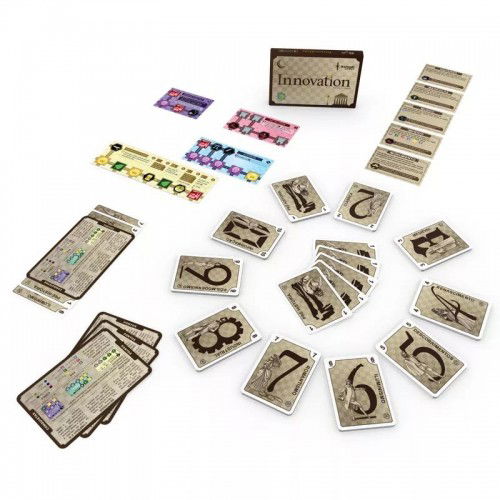
Our civilization evolves as we combine factors from each Era, bringing new ideas, innovations, technologies, and icons related to advancements. The game encompasses the following 10 Eras:
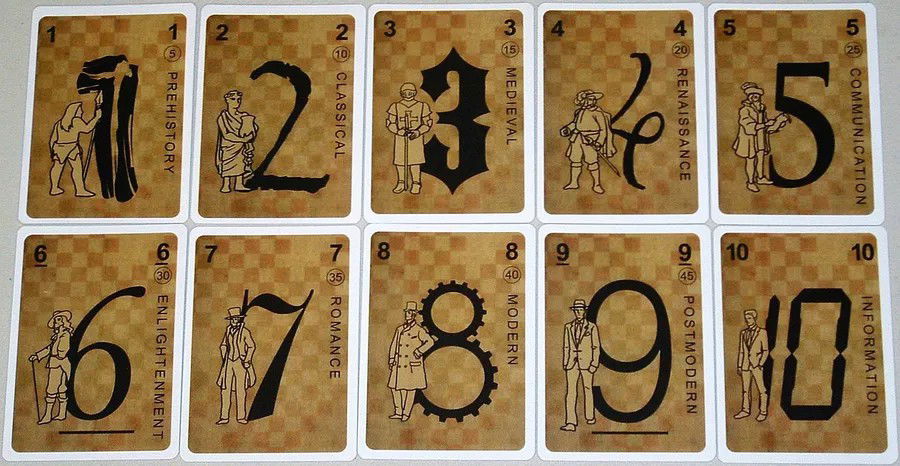
Each Era offers characteristic discoveries and innovations, in addition to icons that are essential for the game and also correspond to the historical context of the time. Some examples of icons are:

These icons appear more or less frequently depending on the Era, and some even disappear in certain phases of the game, creating a strategic tone as the game progresses. The icons are fundamental for both attacking and defending, as we will see later.
At the start of the game, all players begin with 2 cards from the Prehistoric Era, choose one to place in front of them, symbolizing this advancement in their civilization, while the other card remains in their hand for future use (or not).
As mentioned, all Era cards are unique—meaning each of the 105 cards is different, ensuring that no civilization has the same technology as another.
After that, the player's turn is simple. They must choose 2 out of 4 actions:
Note that the same action can be executed 2 times, and this can make all the difference!
The action of Drawing a card allows you to draw an Era card equal to the value of the highest Era card you have already played, meaning if you have only played cards from Era 1, you can obviously only draw cards from Era 1. This action is crucial for the game, as it is only through this action that the Eras advance; if everyone draws cards from Era 1, it will inevitably run out at some point, and then we can only draw cards from the next Era, i.e., Era 2, and thus the Eras advance.
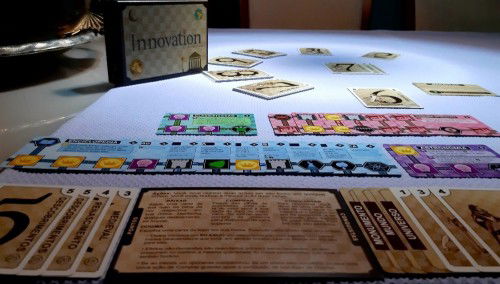
Playing cards is the way to truly show all players your discoveries and innovations, and with this action, as previously mentioned, you can gain access to new Eras with discoveries that can assist you even further.
Played cards have icons and actions (Dogmas) that can be utilized.

Executing a Dogma is perhaps one of the best actions in the game, as executing the actions of the cards is not only the only way to score points but also one of the ways to attack your opponents, weakening them.
The attack actions of Dogma are generally meant to harm opponents, hence the expression "take that." To attack or defend, the counting of the number of icons is crucial. So it is clear that investing in Era cards with different icons makes perfect sense.
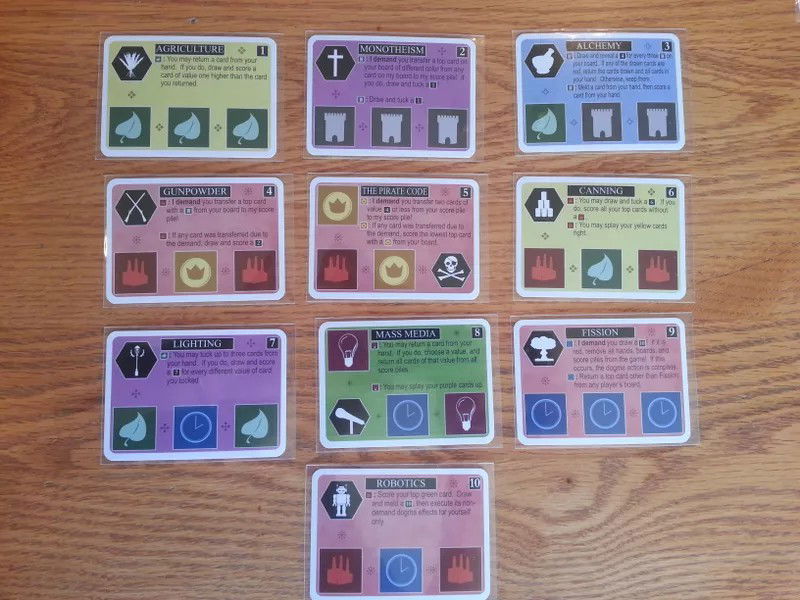
Finally, the action of Achieving will only be possible under 2 conditions:
Keep in mind that achieving in Innovation is an extremely strategic maneuver, requiring attention to various factors.
Having done 2 of the 4 possible actions in your turn, it is the turn of the next player to your left. This is basically a turn in Innovation!
Finishing the Game
In Innovation, the game can end immediately in 2 ways:
OR
Strategic Tips
The golden tip in Innovation is: constantly evolve! While you need to make the most of the resources (icons and Dogmas) from each Era, evolution is the secret to everything, as the actions of the cards become more powerful, new icons will appear, and new paths for your civilization will open.
Knowing when to draw cards is crucial, as the cards from each Era are limited. Delaying your turn to draw cards may allow you to wait for your opponents to draw cards and unlock the new Era for your next turn. Is it a risk? Yes, but it can be mitigated if you notice that your opponents have few cards in hand and will inevitably need to draw cards. Keep an eye on that!
Playing cards is very important, as this is how we advance and allow ourselves to progress through the Eras with “our own legs,” without relying on a depleted Era pile; it is the achievement of your autonomy in the Eras.
At this moment, it is crucial to look at the icons available on the cards, as some of them disappear as the Eras progress, so it’s good to invest in them early in the game and also seek a variety of them.
Try to play cards with good actions to execute (Dogmas), as this is the only source of points for winning.
Now, a note about playing cards that makes a significant difference. Although there are 10 Eras in the game, the cards are only of 5 different colors, and when you play cards, they stack on top of the cards of their respective color – meaning when you play a card, it covers the others of the same color, so only the top card remains visible and usable as a Dogma.
This must be thought out carefully; it’s not just about advancing recklessly; you need to know that you will be giving up a technology or action in favor of the new technology. Now you might think that if a card is from a higher Era, it will obviously be better, period. It’s not that simple. Sometimes, you can create synergy among the available cards, and by covering one of them, that chain of events simply ceases to exist. It’s a dilemma, and that makes Innovation very different from other civilization games.
And now for the cherry on top! Some Dogma cards have actions to Slide a stack of cards that you have already played. That’s right, slide! As mentioned earlier, you will end up with 5 stacks of played cards of different colors, but only the top card of each stack will be showing. The Slide action allows you to slide the stack of cards in one of four options, namely:
This will allow some icons that are near the edges of the cards, previously unavailable because they were on the lower cards, to appear and combine forces with other icons of the same type to attack or defend against opponents. Check out the image below.
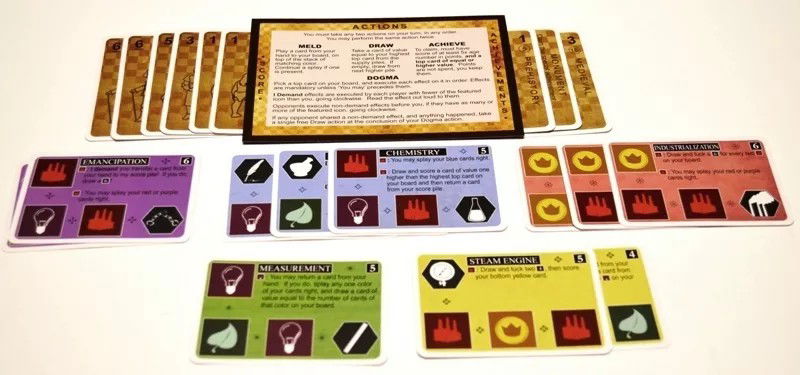
This action is so important that sometimes you can achieve Conquests through sliding, which can be to the left, right, up, or down. In some directions, more icons will be available. Use this as your strategy.
Regarding Conquests, here’s an important fact: there are Era-specific Conquests, achieved through points, but there are also special Conquests that are acquired through conditions during the game. Keep an eye on that!
Follow these tips, evolve your civilization through the Eras, and win in Innovation!
Unboxing, Rules, and Gameplay Videos
Enjoy the Unboxing:
Watch a Rules video:
Pedagogical Tips
If you’re looking for a highly strategic and immersive game based on technologies and real achievements of humanity, and on top of that, want to gain a history lesson, Innovation is the right game for you!
Innovation is about advancements through the Eras; however, there is synergy among these technological innovations and new discoveries. It’s up to you to find the connection between them, and that is pure strategy with a touch of logical reasoning.
Managing the cards, the Eras, whether to advance faster or not, all of these will be strategic decisions to be made constantly. This makes Innovation such a cerebral game.
As you play, you learn about the specific and characteristic advancements of each Era, which is a huge discovery and directly tied to this – in other words, it’s a history lesson.
As a teacher, I recommend that parents do this with their children: take the opportunity to learn about the entire deck of the game while also searching the internet for the history of each of these 105 technologies available in the game. It will be a very fun and educational activity to do with your children.
Pedagogically, Innovation is a history lesson of humanity in the format of a game!
I recommend Innovation for your collection!!!









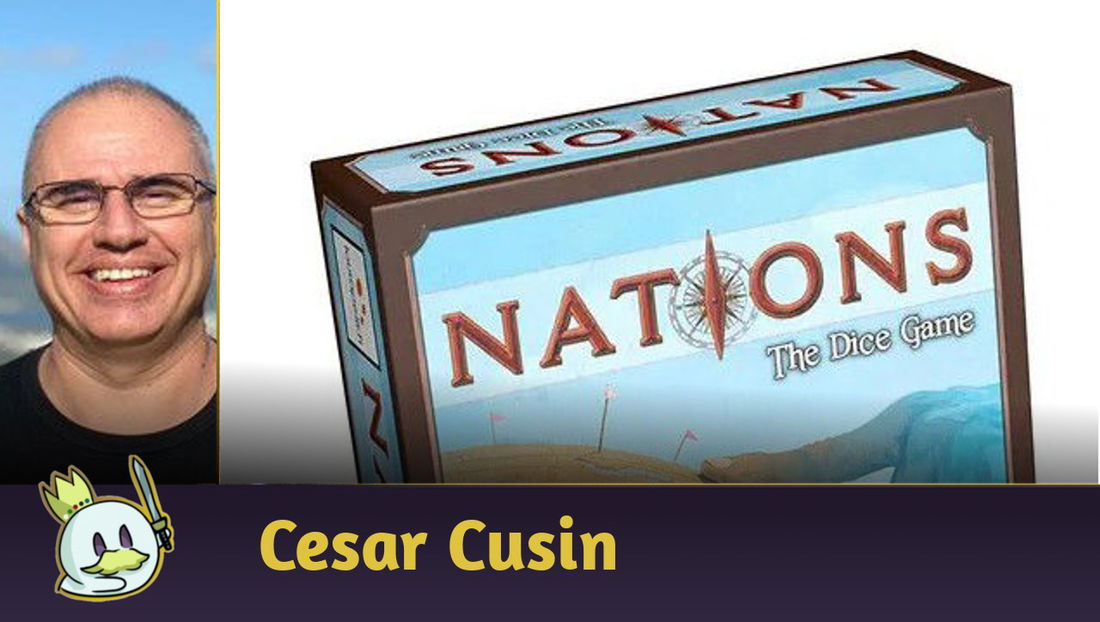



— Comentarios 0
, Reacciones 1
Se el primero en comentar